Favorite Products
Overview
Favorites allow company administrators or individual users to save common configurations and frequently selected parts for quick access when creating quotes.
The favorites UI enhancements provide a new user experience for viewing and managing favorites. The following functionality is available from the Favorites Products page:
- Search favorites to quickly locate favorites that contain the specified text or numeric values.
- Sort favorites using a predefined set of attributes (i.e. Last Modified, Created, Price, Label, and Name).
- Create and manage folders to organize favorites.
- Perform actions on Favorites like Copy, Move, Move to Trash, Share, View Details, Reconfigure, Add to Quote, or Add to Cart.
- Change the display of favorites by category.
- My Favorites show favorites the user owns.
- Company Favorites shows the favorites that were created by the company's favorites administrator. Company Favorites are a successor to the previous favorites sharing method and previously created and shared folders will incur no data or permission losses upon upgrade.
- Shared with Me shows favorites that other users have shared with the logged in user.
- Select specific favorite folders when viewing My Favorites or Company Favorites.
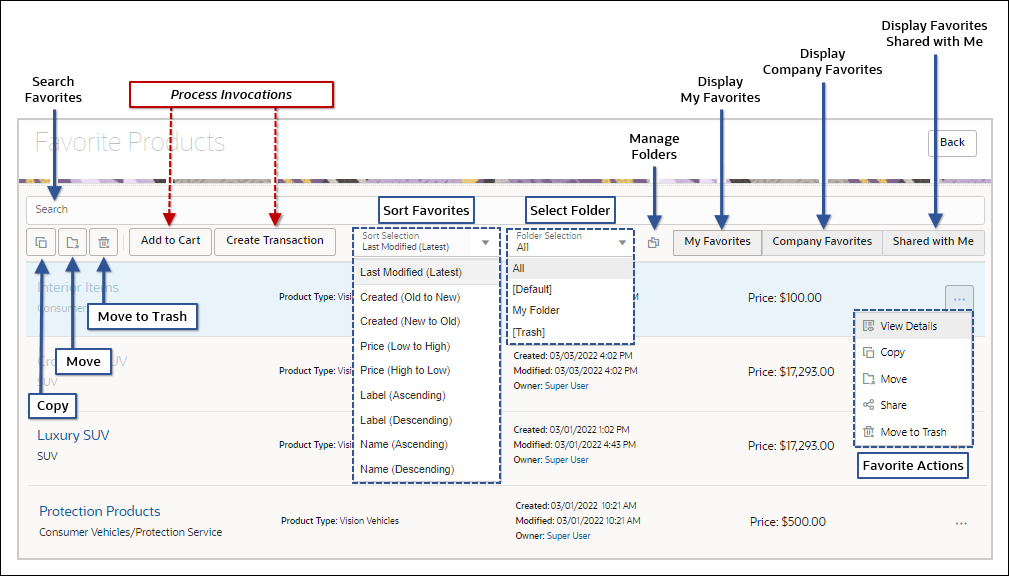
The following functionality is available from the Favorites Products page:
![]() Favorite Actions on the Favorite Products Page
Favorite Actions on the Favorite Products Page
The actions that are available on this page are based upon ownership and access permissions.
- Select a single or multiple favorites to use actions in the top toolbar. Right-click the Favorite Actions drop-down to perform actions on a single favorite.
- The favorite owner can view details, copy, move, share, and move the favorite to the trash. If the favorite owner moves a shared favorite to trash, it removes the favorite from all shared users/groups and only the favorite owner will be able to access the deleted favorite in their Trash folder.
- If a favorite is specifically shared with a user and assigned Edit Access, they can view details, copy, share, and remove their own share permissions. If a favorite is shared with a user's sales group and the group is assigned Edit Access, they can only view details, copy, and share the favorite.
- If a favorite is shared with a user and assigned View Access, they can only copy and view favorite details.
- Create a transaction from a favorite and add a favorite to a shopping cart using predefined process invocations. To add Create a Transaction and Add to Shopping Cart buttons to the Favorite Products page, refer to CPQ Administration Online Help – Invoking a Commerce Process.
Quickly locate favorites that contain the specified text or numeric values.
Favorite Search Tips and Considerations:
- Search results are returned for favorite items that contain the search criteria.
- Favorite searches are case insensitive.
- • Percent ( % ) - This character is reserved as a wildcard character, and thus isn't searchable (e.g. "C%" will match favorites beginning with "C", such as "Car", "Cable", etc.).
- Underscore ( _ ) - This matches any single character (e.g. "a_e" will match any favorite having "a" and "e" with any character in between).
- At sign ( @ ) - Since Owner User Email is one of the search fields, this character will always be present, and therefore a search for "@" will return all rows. A search for "@" as part of a pattern (e.g. "@@", "@oracle") however will only return items that contain the pattern.
- Period ( . ) – Since this character will always be present, a search for "." will return all rows. A search for "." as part of a pattern (e.g. ".." or ".oracle") however will only return items that contain the pattern.
- Users can't search for a favorite using both First and Last names (e.g. John Smith). Since the search runs a query comparing the entire string "John Smith" against the first name value and then the last name value the query will not return a match.
![]() My Favorites | Company Favorites | Shared with Me
My Favorites | Company Favorites | Shared with Me
The following buttons allow users to change the display of favorites by category.
- My Favorites shows favorites the logged in user owns.
-
Company Favorites shows favorites inside company folders with access assigned to a user group that the logged in user is associated with.
Company Folders are a successor to the previous favorites sharing method.
Existing shared folders will incur no data or permission losses upon upgrade to CPQ 22B.
- Shared with Me shows favorites that other users have shared with the logged in user.
The Sort Selection drop-down allows users to sort favorite items using a predefined set of attributes (i.e. Last Modified, Created, Price, Label, and Name).
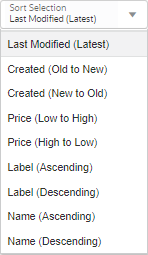
Users can view a specific folder when viewing My Favorites or Company Favorites categories.
- When viewing My Favorites, the Folder Selection drop-down will show personal folders.
- When viewing Company Favorites, the Folder Selection drop-down will show company folders that the logged in user has access to.

Users can click on the Manage Folders icon to add, edit, or delete favorite folders. The options that are displayed are dependent on the user type. The following functions are available in the Manage Folders dialog:
- All users can add new favorite folders, they can also edit and delete their own favorite folders.
- Folder icons, which are listed for each folder, identify if the current user owns the folder and if the folder is a company folder.
- The Translations button is only displayed for Full Access administrators with Favorite List privileges.
![]()
When a user clicks on the Edit Folder icon or the Add Folder icon, the folder properties are displayed.
Personal Folders
Sales users can create favorite folders to manage their own favorites. The following folder properties are available when creating of editing a personal favorite folder:
- Folder Label the name of the favorite folder.
- Click the Save icon to keep changes and close the folder properties.
- Click the Cancel icon to cancel changes and close the folder properties.
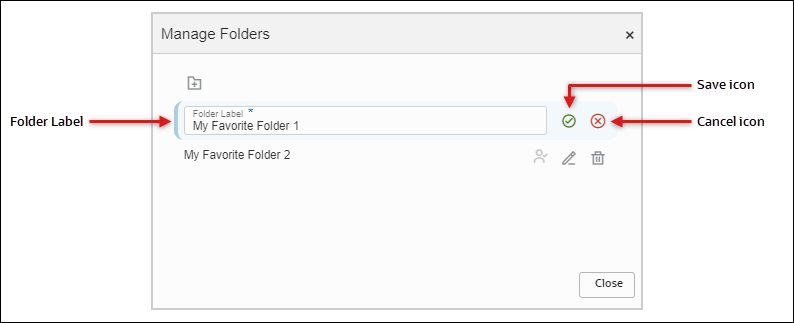
Company Folders
Company favorite folders are shared with individuals or sales groups. Only Full Access administrators with Favorite List privileges can create and edit company favorite folders.
The following folder properties are available when creating of editing a company favorite folder:
- Folder Label the name of the favorite folder.
- Select the Company Folder option to share a favorite folder. When enabled, Full Access users can select predefined user groups to assign permissions.
- View Access Users in the assigned user group can only view favorites inside this folder.
- Add Access Users in the assigned user group can add favorite items to this folder.
- Translations Full Access administrators with Favorite List privileges can provide translations for favorite folders.
- Click the Save icon to keep changes and close the folder properties.
- Click the Cancel icon to cancel changes and close the folder properties.
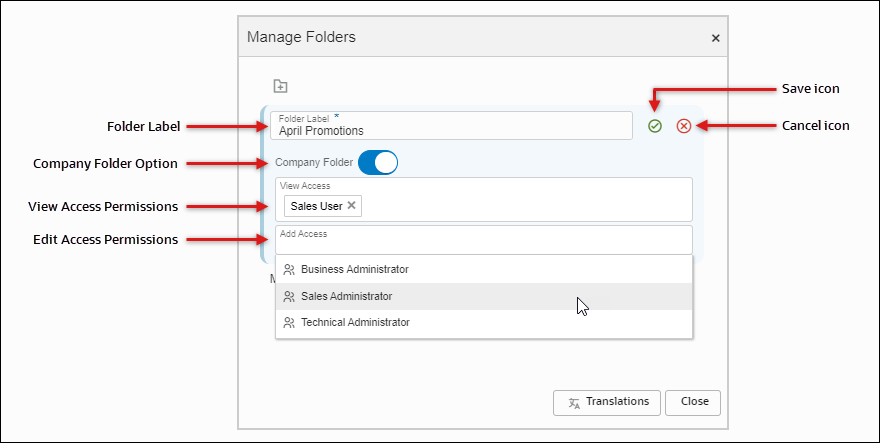
To view favorite details, click on the favorite label or select View Details from the Favorite Actions drop-down.
Remove Me allows the user to remove themselves from the shared favorite.

The favorite label, description, product information, and model information are displayed on this page.
- Product Information displays the Supplier, Currency, Language, and Pricebook.
- Model Information displays the BOM Display Name, Product Family Name, Product Line Name, and Model Name.
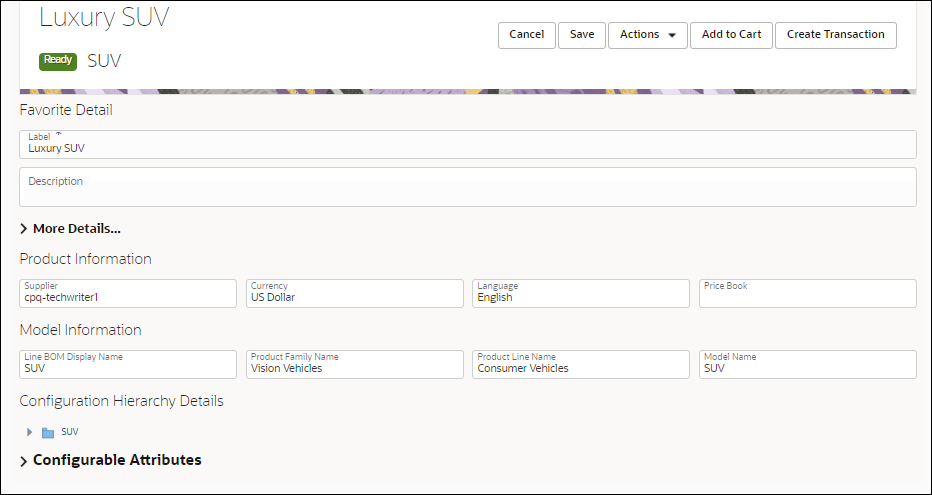
Additional information can be accessed by expanding More Details, Configurable Attributes, or Configuration Hierarchy Details (if applicable). Users can also use the Actions drop-down to perform various actions.
When users expand the More Details section, they can view: product type, quantity, price, owner, created date, created by, modified date, and modified by.

![]() Favorite Actions on the Favorite Detail Page
Favorite Actions on the Favorite Detail Page
The actions available on the Favorite Detail Page are also based upon ownership and access permissions.
- The favorite owner can modify then save the favorite, reconfigure, copy, move, share, move the favorite to the trash, and invoke commerce process actions. If the favorite owner moves a shared favorite to trash, it removes the favorite from all shared users/groups and only the favorite owner will be able to access the deleted favorite in their Trash folder.
- For shared favorites with Edit Access, users can modify then save the favorite, reconfigure, copy, update shared access, and invoke commerce process actions.
- For shared favorites with View Access, users can only copy the favorite and invoke commerce process actions.
The following image shows the favorite actions that are available for favorite owners, shared favorites with edit access, and shared favorites with view access.

![]() Configuration Hierarchy Details
Configuration Hierarchy Details
The Favorite Products page consolidates all items within a configuration into one favorite item, which can be expanded when viewing the Favorite Detail page. BOM items, System Models, Recommended Items (optional and mandatory), and BOM-aware part associations now appear in the hierarchy under the model that called them. If applicable, users can click on the root node in the tree to view the system hierarchy, models, and parts. For more information about configuration hierarchies, refer to Oracle CPQ Administration Online Help > Configuration > System Configuration.
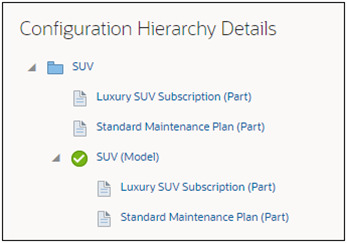
When users expand the Configurable Attributes section, the configuration values for the favorite are displayed.

Status badges on the Favorites List and Favorites Detail page inform users whether products have changed since they were added to the list. Status badges are only updated after a scheduled update is executed. The following table lists favorite badges, the location where the badge is displayed, and a description for available badges.
Status
Favorite lists are maintained independently of catalog and parts. Because of this separation, products in the Favorites list can become out of sync with the catalog products/parts they reference. Administrators can schedule favorite updates to ensure that a user's Favorites list is synchronized with the catalog and parts. The Favorites List updates its display to the user in several ways. Certain updates appear without any user notification, like pricing and product attribute changes. Other updates change the status of items on the Favorites List, such as products that are no longer available or that must be reconfigured.
|
Badge
|
Location
|
Description
|
|---|---|---|
|
|
Favorites Details |
Green, items that can be directly purchased from the Favorites. |
|
|
Favorites Details, Favorites List |
Red, items that are no longer available for purchase because they have been removed from the catalog or changed from a direct buy to a non‑direct buy. |
|
|
Favorites Details, Favorites List |
Blue, items that require user reconfiguration before purchase. |
|
|
Favorites Details, Favorites List |
Red, items that shouldn't be sold directly, but rather included within a BOM or as a recommended item under a model. |
Beginning in Oracle CPQ 22B, administrators can no longer customize status badges.
![]() Favorites Support for BOM-Related Models
Favorites Support for BOM-Related Models
Favorites allow each user to list their Favorite products and parts for quick access and quote creation in a Favorites List. Favorite lists are maintained independently of catalog and parts. Users can save BOM-related models and system configurations as Favorites. Associated parts and models are displayed in their hierarchical order. A system configuration can be added to Favorites from Configuration or Commerce. The only BOM item that can be chosen is the root. However, recommended items from either the root model or any descendant model can be independently added as Favorites from Commerce. From within Configuration, the entire system will be added as a Favorite along with all of the currently selected recommended items. When optional and mandatory recommended items are added to Favorites they will appear directly below the model that added them.
When non-BOM Favorites are added to a Transaction, the items are added exactly as they are saved in Favorites. The behavior for non-BOM items and previously saved Favorites are not changed in Oracle CPQ 19B.
When BOM-based Favorites are added to a Transaction, the items may differ from Favorites since they go through invocation prior to being added to a Transaction. This behavior is different than the existing Favorites functionality.
When a model has a defined BOM Mapping Rule, any changes to Recommended Item Rules or pricing will impact what gets added to the Transaction. Therefore, what is seen in Favorites may not match what is added to the Transaction. Updated items can be synchronized to Favorites by reconfiguring and saving the modified items. The following circumstances cause changes to occur:
- If a Recommended Items Rule that is active on the BOM-related Favorite has item changes, the BOM items are updated to reflect the items defined in the rule.
- If a Recommendation Rule that is active on the BOM-related Favorite has item changes, the recommendation will fire on invocation according to its new condition requirements, action attributes, and values.
- If a Pricing Rule that is active on a model included in a BOM-type Favorite is changed, the prices will be updated.
- If Attribute Value Pricing (AVP) is changed, the prices are updated according to the current AVP prices.
Under some circumstances invocation is blocked and the BOM-related Favorites must be reconfigured before the items can be added to a Transaction. The following circumstances cause invocation to fail:
- If the BOM hierarchy is changed and doesn't match the BOM-related Favorites.
- If system updates cause constraint errors on the root or child models.
Favorite entries are created for the entire system configuration and all potential recommended items. These entries are all visible on the Favorites page.
The following BOM-related information is displayed in the Favorites list:
- Name: the attribute mapping item name or BOM model name for models and the attribute mapping item name, part display name, or part number for parts
- Quantity: the effective or exploded quantity, i.e. multiplied by the parent Quantity
- Total Price: For BOM models, line quantity can be more than one, the total price uses this quantity when calculating the total price for the Favorites item. This is different from the standard Configuration total price, where the unit price assumes the model quantity is one.
The Favorites Detail page provides information for the selected Favorites line item. The following table describes the sections on this page and indicates if the section is available for root items, child models, or parts.
|
Section |
Availability |
Description |
|---|---|---|
|
Description |
Root Items, Child Models, and Parts |
This section contains a "Label" item that allows users to rename the Favorites line item. |
|
General Information |
Root Items, Child Models, and Parts |
This section displays the supplier, product type, quantity, total price, currency preference, language preference, and price book information. |
|
Model Information |
Root Items and Child Models |
This section displays the line BOM display name, segment name, product line name, and model name. |
|
System Configuration Information -OR- BOM Information |
Root Items |
This section displays a visual representation of the system navigation. This section is called "BOM Information" when none of the child items are configurable. |
|
Configurable Attributes |
Root Items and Child Models |
This section provides a list of configurable attributes within the model. The Reconfigure option is only provided in this section for the system configuration root item. This option allows users to reconfigure system configuration Favorites. |
|
Part Information |
Parts |
This section contains information about parts items, such as: part number, lead time, price type, etc. |
User Actions
![]() Adding Favorites from Commerce or Configuration
Adding Favorites from Commerce or Configuration
When a user invokes Copy to Favorites from the JET Configuration UI or the JET Transaction UI, the Favorites popup will appear. The Folder drop-down will display the Default folder, personal favorite folders, and Company Folders that the user has Add access to.

If Copy to Favorites is invoked from the legacy Configuration UI or the legacy Transaction UI, the favorite creation will revert to the previous behavior. (i.e. Favorites are placed in the Default folder and the default name for favorites is "Model" for models and "Part" for parts.)
Beginning in Oracle CPQ 22A support has been added to invoke a Commerce Transaction when reconfiguring an item from the Favorites List. The Commerce invocation action will be visible on the Configuration page when a Favorite is reconfigured. Prior to this feature implementation, users would need to save the reconfigured Favorite and exit Configuration, and then go into Commerce to add the Favorite to a quote. This features saves the user multiple steps when adding a reconfigured Favorite to a new or existing quote.
![]() Renaming Configuration Favorites
Renaming Configuration Favorites
-
Navigate to your Favorites.
-
Click on the favorite Label or select View Details from the Favorite Actions drop-down.
-
Change the value in the Label field.
This is the value that will appear on the Favorites page.
-
Click Save.
User can share a favorite with individual users or with predefined groups. Sales users can also share favorites using company folders. The new sharing features provide consistent access behavior for shared items and allow sales users to share favorites and favorite folders.
- If a favorite is specifically shared with a user and assigned Edit Access, they can view details, copy, share, and remove their own share permissions. If a favorite is shared with a user's sales group and the group is assigned Edit Access, they can only view details, copy, and share the favorite.
- If a favorite is shared with a user and assigned View Access, they can only copy and view favorite details.
Share a Favorite with Individuals or User Groups
When sharing a favorite, the favorite owner can assign the following types of access:
- View Access only allows the specified users/user groups to view the current favorite, create a transaction from the favorite, and add the favorite to a shopping cart.
- Edit Access allows the specified users/user groups to edit the current favorite.
In the following image, the favorite owner uses the Share action to assign View Access to a specific user (Amy Smith) and Edit Access to the Sales Administrator group.
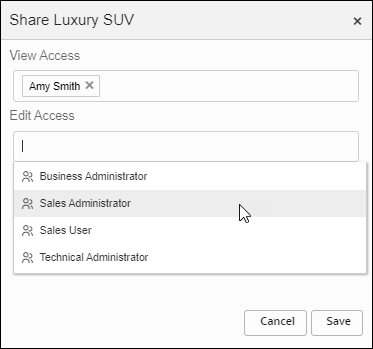
When Amy or user's in the Sales Administrator group access favorites, they can select Shared with Me to view favorites that are shared with them.

Share a Favorite Using a Company Folder
In the following example the user selects the April Promotions folder when creating a favorite.Note that the April Promotions folder is followed by [Company Folder], which denotes it is a company folder.
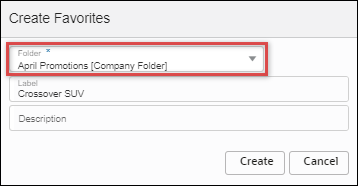
When a favorite item is placed into a company folder, the favorite ownership is transferred to the company folder owner. When the ownership is transferred to the company folder owner, the original owner is assigned Edit Access.
Prior to Oracle CPQ 22B, favorite ownership didn't change when a favorite was moved from a private favorite folder into a company folder. Anyone with Edit Access for a favorite could move the favorite into a shared folder. At that point, the original owner would lose access to their favorite if they weren't the owner of the favorite and the private favorite folder. The new behavior eliminates issues with favorite ownership when a favorite is moved from a private folder to Company Folder.
To view a favorite that is inside a company folder, select Company Favorites. The Company Favorites shows all favorites for every shared folder the user has assigned access.
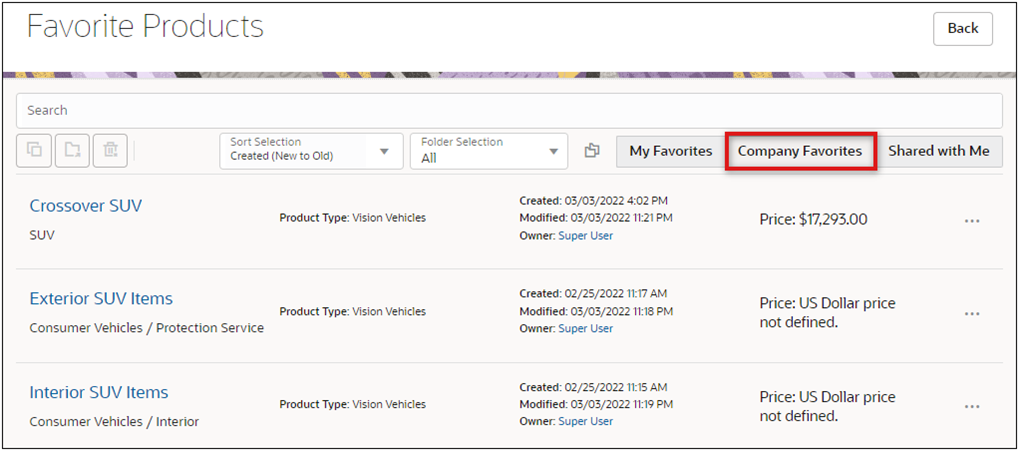
Notes
Notes: Refer to Favorites Administration for information about enabling and managing Favorites.









